BIOLOGICAL GROWTH AND DEVELOPMENT Lesson 1 Prenatal Lesson 2 Physical and Motor 2.1 Infancy 2.2 Early, Middle, and Late Childhood 2.3 Puberty and Adolescence Lesson 3 Brain Development Lesson 4 Factors Affecting Development: Maternal Nutrition, Child Nutrition, and Early Sensory Stimulation 4.1 Maslow’s Hierarchy of Needs Module II
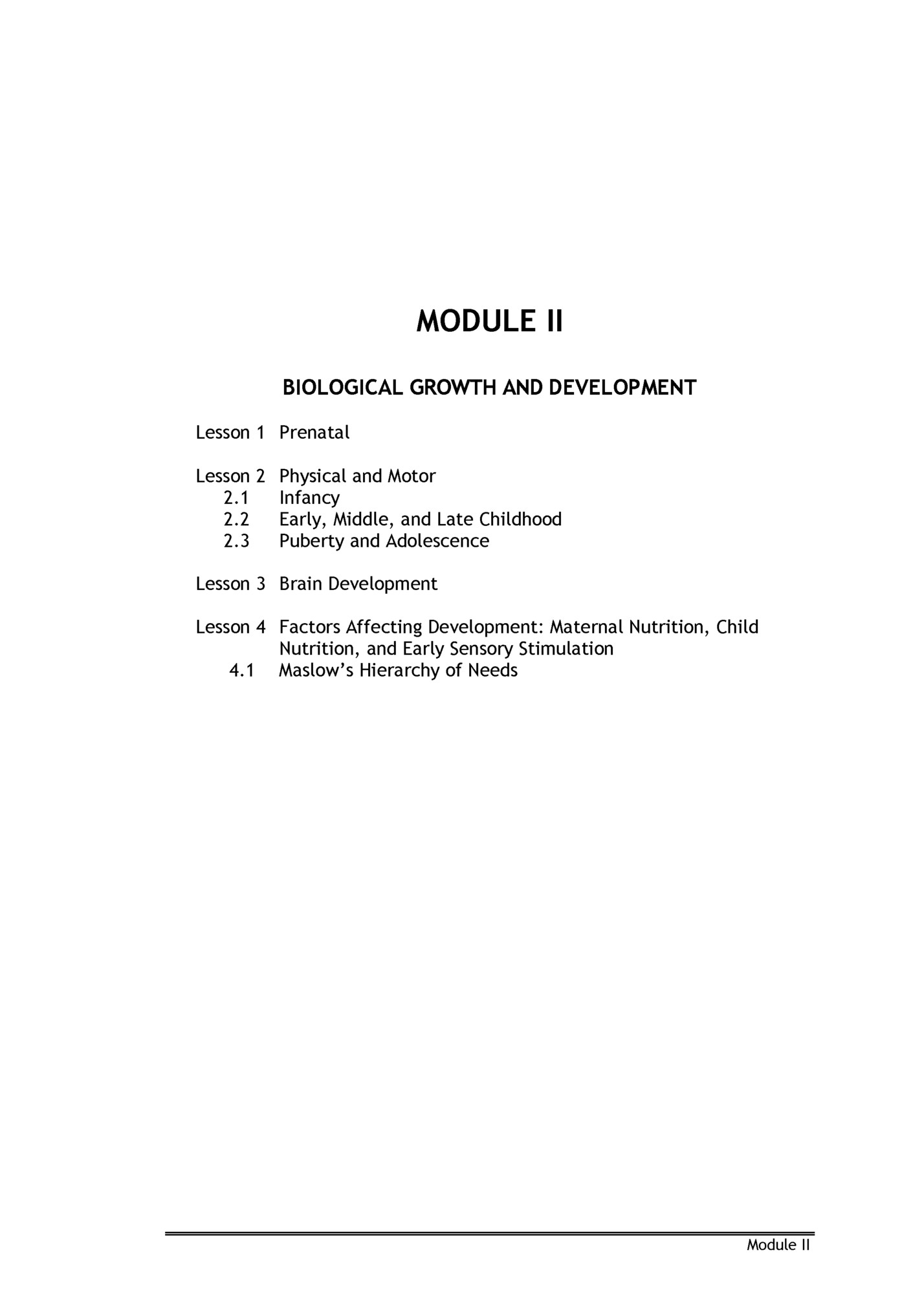
BIOLOGICAL GROWTH AND DEVELOPMENT ¥ INTRODUCTION This module presents the stages of human growth and development. Developmental psychologists often divide our development into three areas, namely physical development, cognitive development, and psychosocial development. According to Erikson’s stages, lifespan development is divided into different stages based on age. We will discuss these stages in this module. OBJECTIVES After studying the module, you should be able to: 1. Identify the stages of prenatal development and recognize the importance of prenatal care; 2. Explain how the developing embryo and fetus may be harmed by the presence of hazards and describe what a mother can do to reduce risk; 3. Discuss physical, cognitive, and emotional development from infancy through childhood to adolescence; 4. Compare and contrast the stages or processes of brain development; and 5. Determine the different factors affecting development in terms of Maternal Nutrition, Child Nutrition, and Early Sensory Stimulation G DIRECTIONS/ MODULE ORGANIZER There are four lessons in the module. Read each lesson carefully, then answer the exercises/activities to find out how much you have benefited from them. Work on these exercises carefully and submit your output to your instructor or to the CE office. In case you encounter difficulty, discuss this with your instructor. If not, contact your instructor at the CE office. Module II
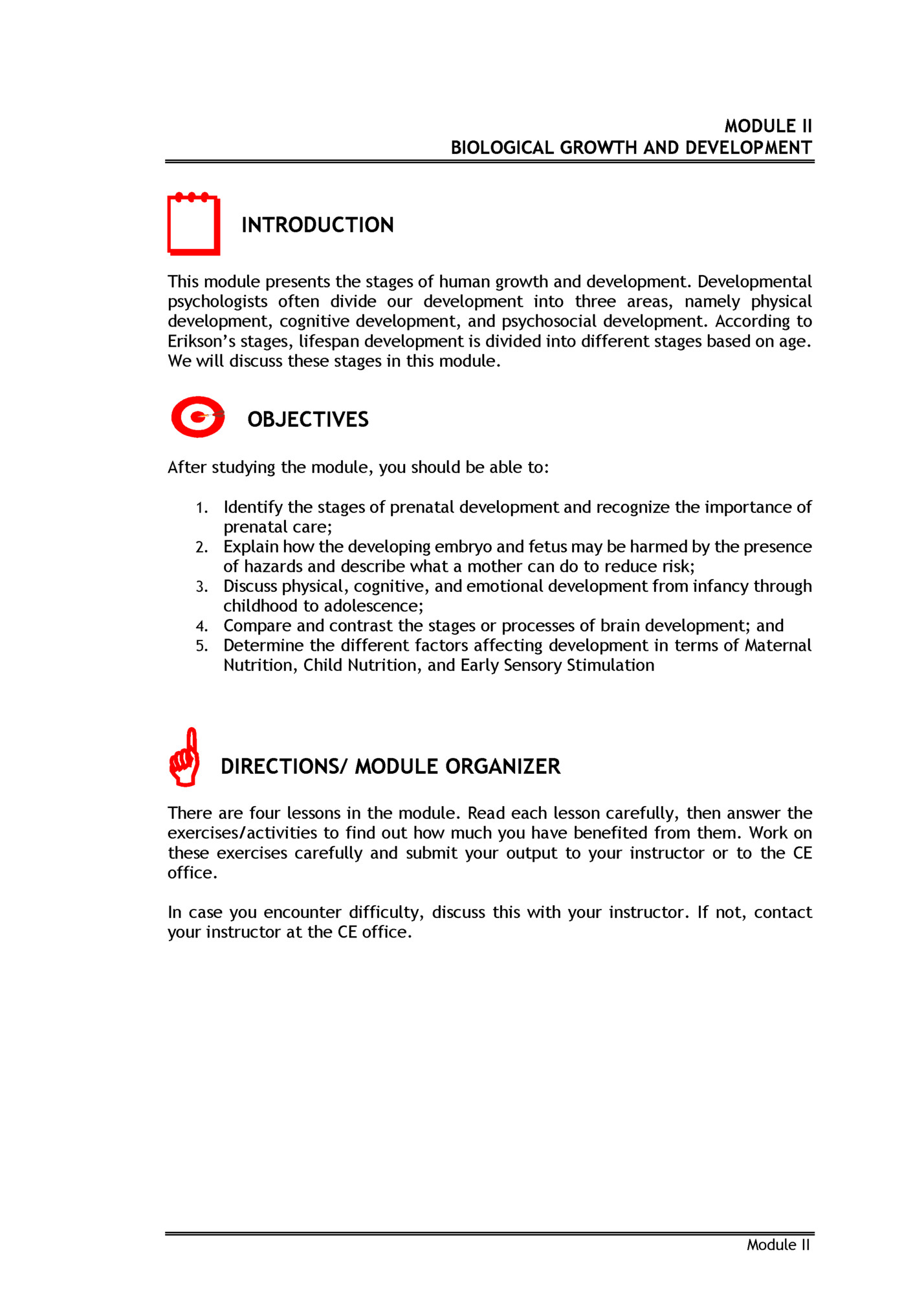
& Prenatal How did you come to be who you are? From beginning as a one-cell structure to your birth, your prenatal development occurred in an orderly and delicate sequence. Prenatal development refers to the process in which a baby develops from a single cell after conception into an embryo and later a fetus. The average time for prenatal development to complete is 38 weeks from the date of conception. During this time, a single-celled zygote develops in a series of stages into a full-term baby. The three primary stages of prenatal development are the germinal stage, the embryonic stage, and the fetal stage. Let’s take a look at what happens to the developing baby in each of these stages. Stages of Prenatal Development 1. Germinal Period (Weeks 1-2) A mother and father’s DNA is passed on to the child at conception. Conception occurs when sperm fertilizes an egg and forms a zygote. A zygote begins as a one-cell structure created when a sperm and egg merge. The genetic makeup and sex of the baby are set at this point. During the first week after conception, the zygote divides and multiplies, going from a onecell structure to two cells, then four cells, then eight cells, and so on. Mitosis is the process of cell division. As the cells divide, they become more specialized, forming different organs and body parts. In the germinal stage, the mass of cells has yet to attach itself to the lining of the mother’s uterus. Germinal Stage 24 to 30 hours after fertilization 36 hours 2 days 3 days 4 days 4 to 5 days 6 to 7 days 11-15 days What’s happening The sperm and egg chromosomes unite. In the fertilized ovum, the zygote divides into two cells. The two cells become four cells. The four cells become a small compact ball, 1632 cells. There is now a hollow ball of 64-128 cells. The inner cell mass called blastocyst is still free in the uterus. The blastocyst attaches to the wall of the uterus. The blastocyst invades the uterine wall of the uterus and becomes implanted in it. This is called implantation. Module II
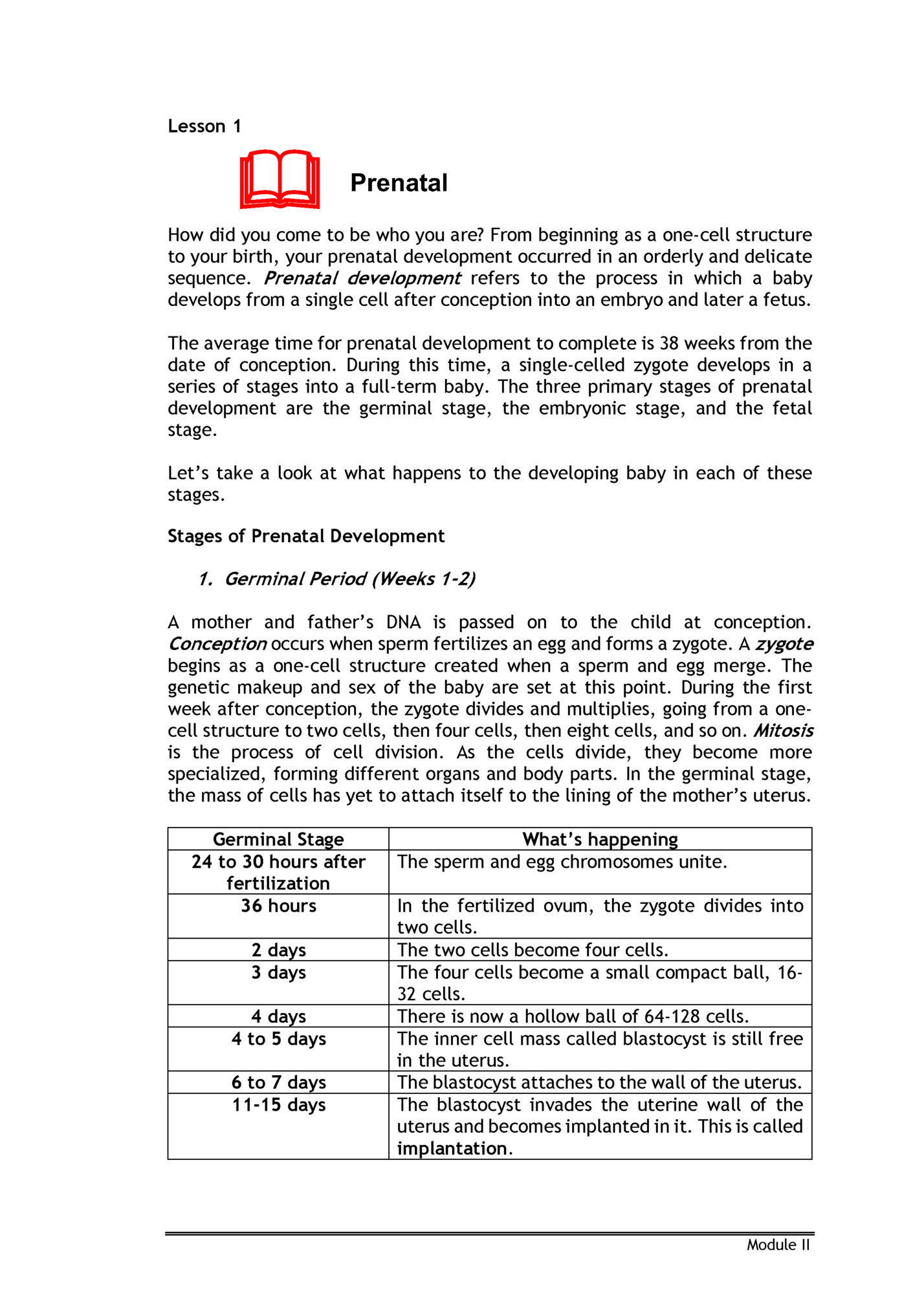
The embryonic stage begins after implantation and lasts until eight weeks after conception. After implantation, the cells continue to divide rapidly, and differentiation occurs. It is a cluster of cells that begins to take on different functions. Gastrulation leads to the formation of three distinct layers called germ layers: the outer layer (ectoderm), the middle layer (mesoderm), and the inner layer (endoderm). As the embryo develops, each germ layer differentiates into different tissues and structures. For example, the ectoderm eventually forms skin, nails, hair, brain, nervous tissue and cells, nose, sinuses, mouth, anus, tooth enamel, and other tissues. The mesoderm develops into muscles, bones, heart tissue, lungs, reproductive organs, lymphatic tissue, and other tissues. The endoderm forms the lining of the lungs, bladder, digestive tract, tongue, tonsils, and other organs. The differentiation process takes place over a period of weeks, with different structures forming simultaneously. Embryonic Stage Events Week 3 Beginning development of the brain, heart, blood cells, circulatory system, spinal cord, and digestive system. Week 4 Beginning development of bones, facial structures, and limbs (presence of arm and leg buds); continuing development of the heart (which begins to beat), brain, and nervous tissue. Week 5 Beginning development of eyes, nose, kidneys, and lungs; continuing development of the heart (formation of valves), brain, nervous tissue, and digestive tract. Week 6 Beginning development of hands, feet, and digits; continuing development of brain, heart, and circulation system. Week 7 Beginning development of hair follicles, nipples, eyelids, and sex organs (testes or ovaries); first urine formation in the kidneys, and the first evidence of brain waves. Week 8 Facial features are more distinct, internal organs are well developed, the brain can signal for muscles to move, heart development ends, and external sex organs begin to form. 3. Fetal Stage (Weeks 9-40) Prenatal development is most dramatic during the fetal stage. When an embryo becomes a fetus at eight weeks, it is approximately 3 centimeters (1.2 inches) in length from crown to rump and weighs about 3 grams (0.1 ounces). By the time the fetus is considered full-term at 38 weeks gestation, he or she may be 50 centimeters (20 inches) or 3.3 kilograms (7.3 pounds). Although all organ systems were formed during embryonic development, they continue to develop and grow during the fetal stage. Module II
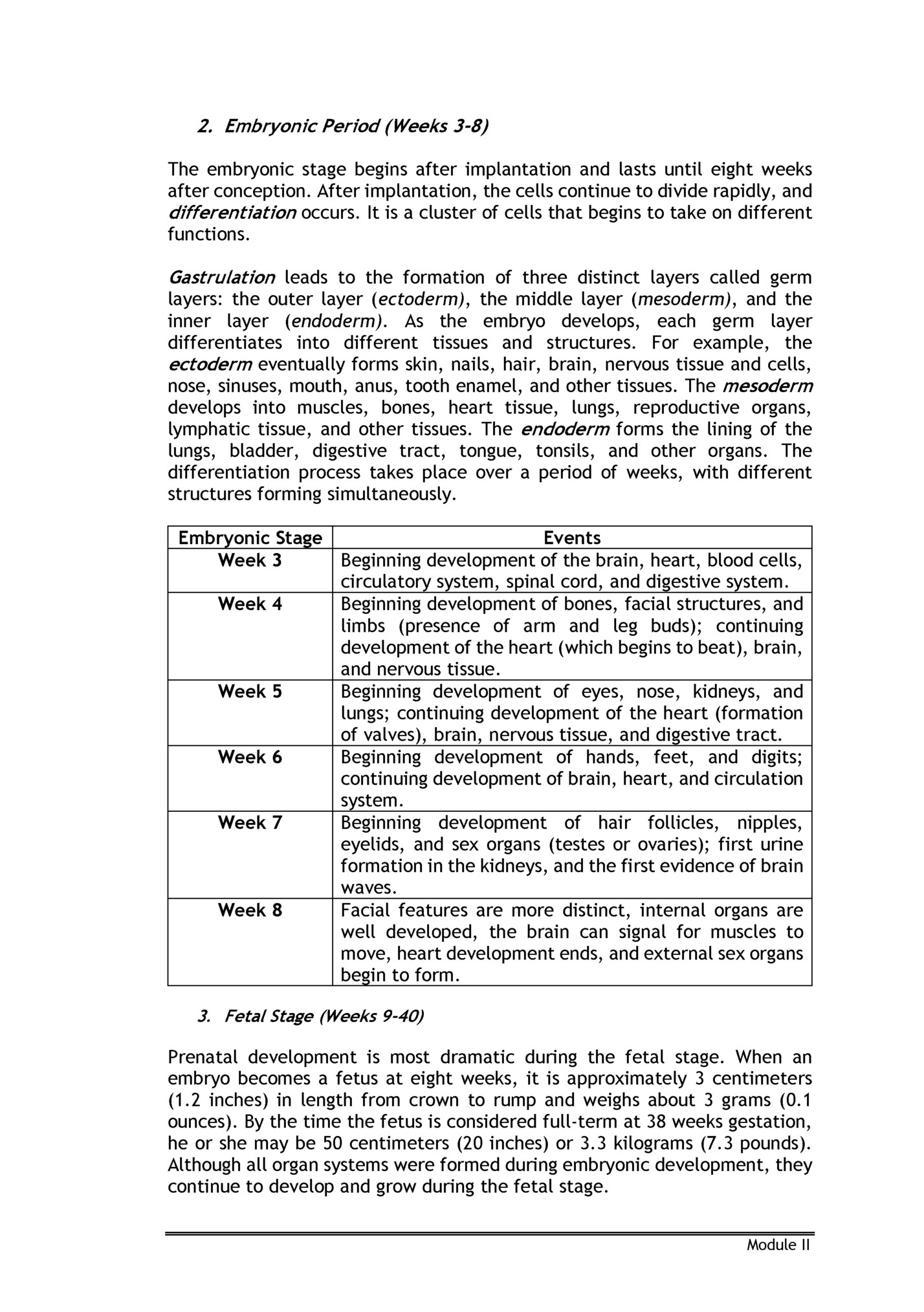
Weeks 9 to 12 Weeks 13 to 15 Weeks 16 to 20 Weeks 21 to 24 Weeks 25 to 28 Weeks 29–32 Weeks 33 to 36 Weeks 36 to 38 Features The fetus reaches approximately 8 cm. (3.2 in.) in length; the head is approximately half the size of the fetus. External features such as the face, neck, eyelids, limbs, digits, and genitals are well formed. The beginnings of teeth appear, and red blood cells begin to be produced in the liver. The fetus is able to make a fist. The fetus reaches approximately 15 cm. (6 in.) in length. Fine hair called lanugo first develops on the head; structures such as the lungs, sweat glands, muscles, and bones continue to develop. The fetus is able to swallow and make sucking motions. The fetus reaches approximately 20 cm. (8 in.) in length. Lanugo begins to cover all skin surfaces, and fat begins to develop under the skin. Features such as finger and toenails, eyebrows, and eyelashes appear. The fetus becomes more active, and the mother can sometimes begin to feel fetal movements at this stage. The fetus reaches approximately 28.5 cm. (11.2 in.) in length and weighs approximately 0.7 kg (1 lb. 10 oz.). Hair grows longer on the head, and the eyebrows and eye lashes finish forming. The lungs continue to develop with the formation of air sac (alveoli); the eyes finish developing. A startle reflex develops at this time. The fetus reaches approximately 38 cm. (15 in.) in length and weighs approximately 1.2 kg (2 lb. 11 oz.). The next few weeks mark a period of rapid brain and nervous system development. The fetus gains greater control over movements such as opening and closing eyelids and certain body functions. The lungs have developed sufficiently that air breathing is possible. The fetus reaches approximately 38–43 cm. (15–17 in.) in length and weighs approximately 2 kg (4 lb. 6 oz.). Fat deposits become more pronounced under the skin. The lungs remain immature but breathing movements begin. The fetus's bones are developed but not yet hardened. The fetus reaches approximately 41–48 cm. (16–19 in.) in length and weighs 2.6–3.0 kg (5 lb. 12 oz. to 6 lb. 12 oz.). Body fat continues to increase, lanugo begins to disappear, and fingernails are fully grown. The fetus has gained a high degree of control over body functions. The fetus reaches 48–53 cm. (19–21 in.) in length is considered to be full-term by the end of this period. Lanugo has mostly disappeared and is replaced with thicker hair on the head. Fingernails have grown past the tips of the fingers. In a healthy fetus, all organ systems are functioning. Module II
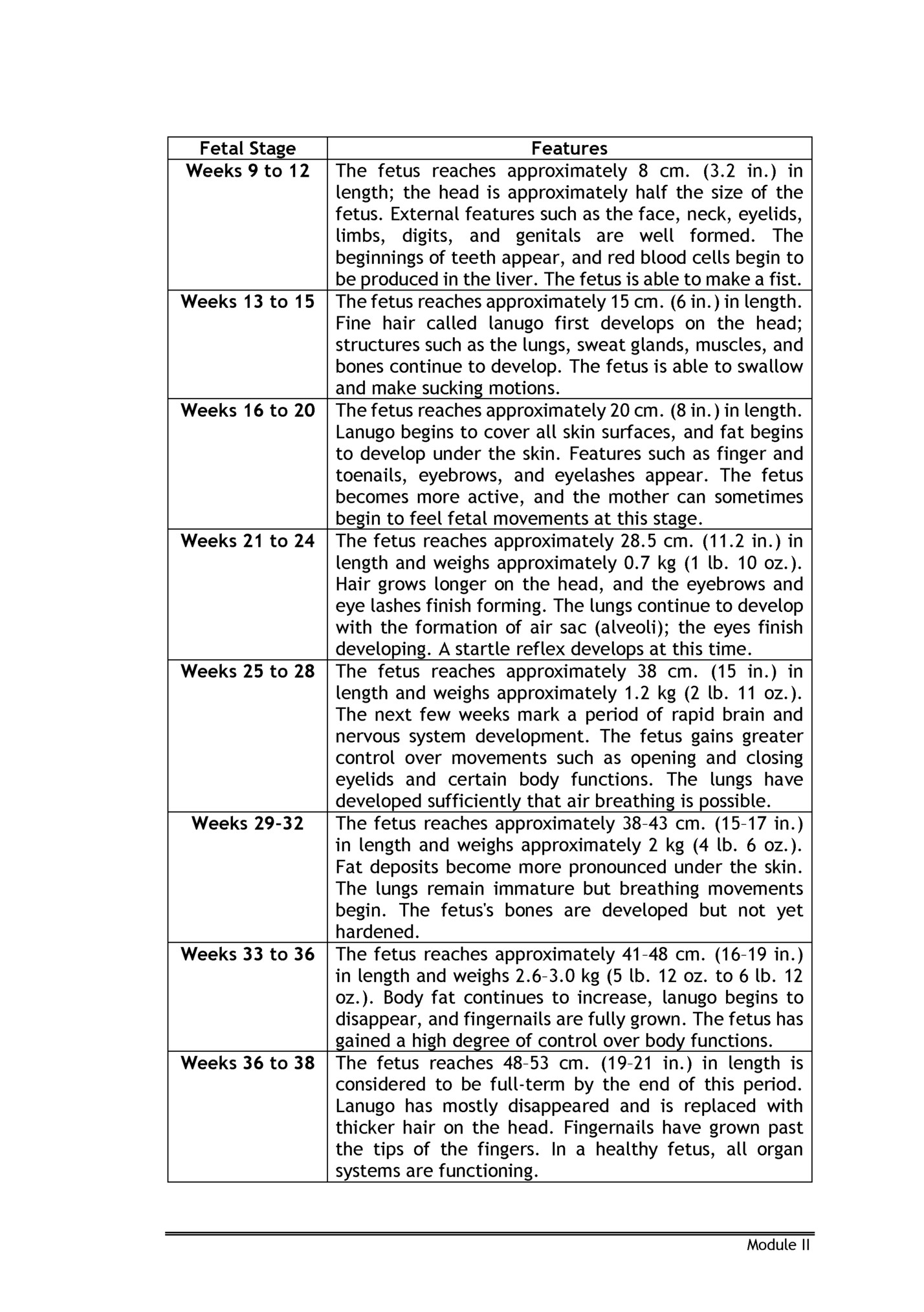
Prenatal development is a complicated process and may not always go as planned. About 45% of pregnancies result in a miscarriage, often without the mother ever being aware it has occurred (Moore & Persaud, 1993). Physical Hazards a. Starvation What might occur The zygote will die of starvation if it has too little yolk to keep it alive until it can lodge itself in the uterine wall or if it remains too long in the tube. b. Lack of Uterine Implantation cannot occur if, as a result of glandular Preparation imbalance, the uterine walls are not prepared in time to receive the zygote. c. Implantation in If the zygote becomes attached to a small fibroid the wrong place tissue in the uterine wall or to the wall of the Fallopian tube, it cannot get nourishment and will die. d. Miscarriages Unfavorable conditions in the prenatal environment are likely to occur between the tenth and eleventh week after conception. e. Developmental Maternal malnutrition, vitamin, and glandular Irregularities deficiencies. f. Problems Older women tend to have more health problems brought by aging than younger women, e.g., high blood pressure is more common in older people. Having high blood pressure before pregnancy can increase the risk of preeclampsia. But studies also show that older women who do not have any health conditions can still have complicated pregnancies. Environmental Hazards Extreme Exposure Prescription and Nonprescription Drugs Psychoactive Drugs Diseases Example Exposure to radiation, pollutants, toxic wastes, and harmful substances such as cigarettes and alcohol Taking harmful drugs such as antibiotics and some nonprescription drugs such as diet pills, aspirin, and coffee. Taking nicotine, caffeine, and illegal drugs such as marijuana, cocaine, and heroin. Rubella (German measles), syphilis, genital herpes, and AIDS Module II
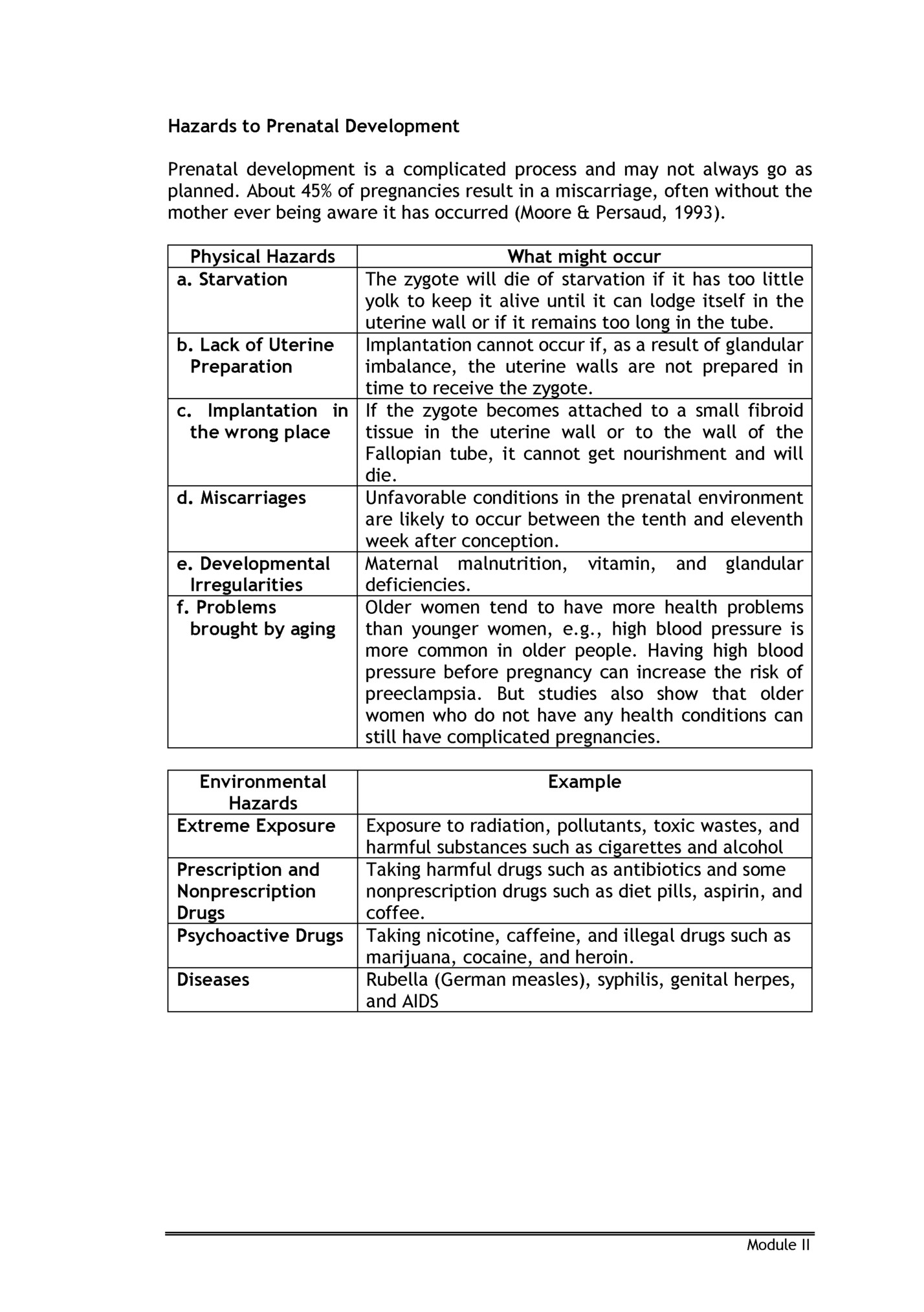
Watch: Browse the link provided to supplement your learning in this topic. National Geographic. (2018). Pregnancy 101 https://youtu.be/XEfnq4Q4bfk?si=BmuvEf3bslEdhViUniversity of Texas. (2022). Ob-Gyn Answers the Most Commonly Asked Questions About First Trimester of Pregnancy - What to Expect https://youtu.be/Jr4nt6XM3gA?si=bUeR6vTCTNida_nZ Respond to the inquiries. Remember that citing the sources given is crucial, and you are free to add any more you come across while reading the materials. 1. What are the proofs that the mother is carrying a living human being in her womb? 2. What are the effects of alcohol, caffeine, and nicotine on developing embryo/fetus? 3. Can you have a healthy baby without prenatal care? Explain. 4. What behaviors must a woman avoid engaging in when she decides to become pregnant or when she finds out that she is pregnant? Module II
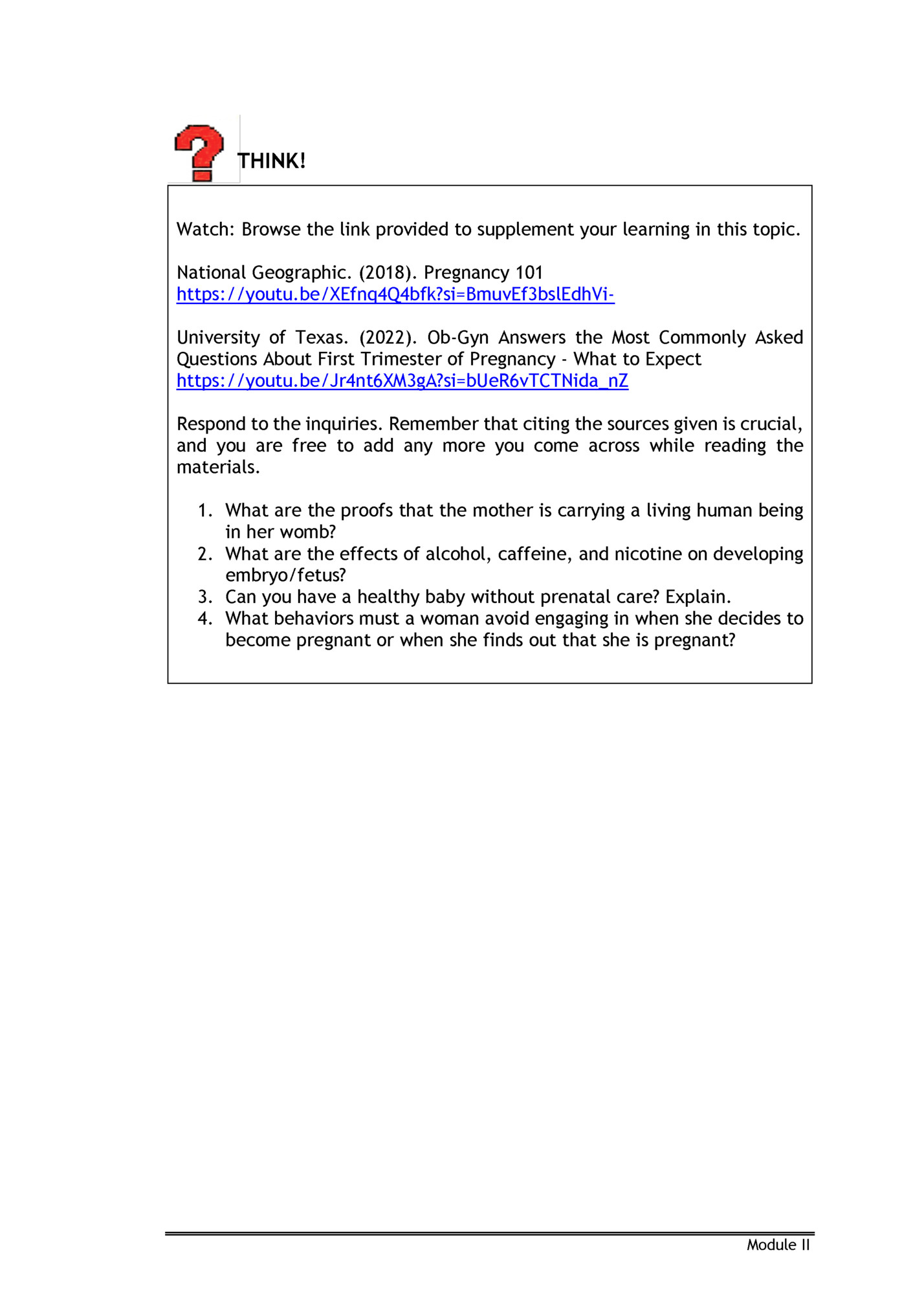
& Physical and Motor Development Any development implies an all-around developmental behavior pattern. Physical and motor development refers to the advancements and refinements of motor skills, or, in other words, the abilities to use and control their bodies. It relates to the growth and skill development of the body, including the brain, muscles, and senses. Categories Fine motor skills Gross motor skills Description These refer to small movements in the hands, wrists, fingers, feet, toes, lips, and tongue. These involve the motor development of muscles that enable babies to hold up their heads, sit and crawl, and eventually walk, run, jump and skip. Development is unified and cumulative; hence the discussion of physical and motor development cannot be restricted only to the growth in size. Let us take a look at the different stages of development. 1. INFANCY - It is the first year of life and is the period of most rapid growth after birth. An infant's physical development begins at the head, then moves to other body parts. Then after birth, the development is most often divided into the following areas: Physical Milestone Development Newborn – • Can lift and turn their head when lying on their back 2 months • Hands are fisted, the arms are flexed • Neck is unable to support the head when the infant is pulled to a sitting position • Infants’ primitive reflexes include: o Babinski reflex (plantar reflex), toes fan outward when the sole of the foot is stroked o Moro reflex (startle reflex), extends arms then bends and pulls them in toward body with a brief cry; often triggered by loud sounds or sudden movements o Palmar hand grasp, infant closes hand and "grips" your finger o Placing, leg extends when the sole of the foot is touched o Plantar grasp, infant flexes the toes and forefoot o Rooting and sucking, turns head in search of nipple when cheek is touched and begins to suck when nipple touches lips Module II
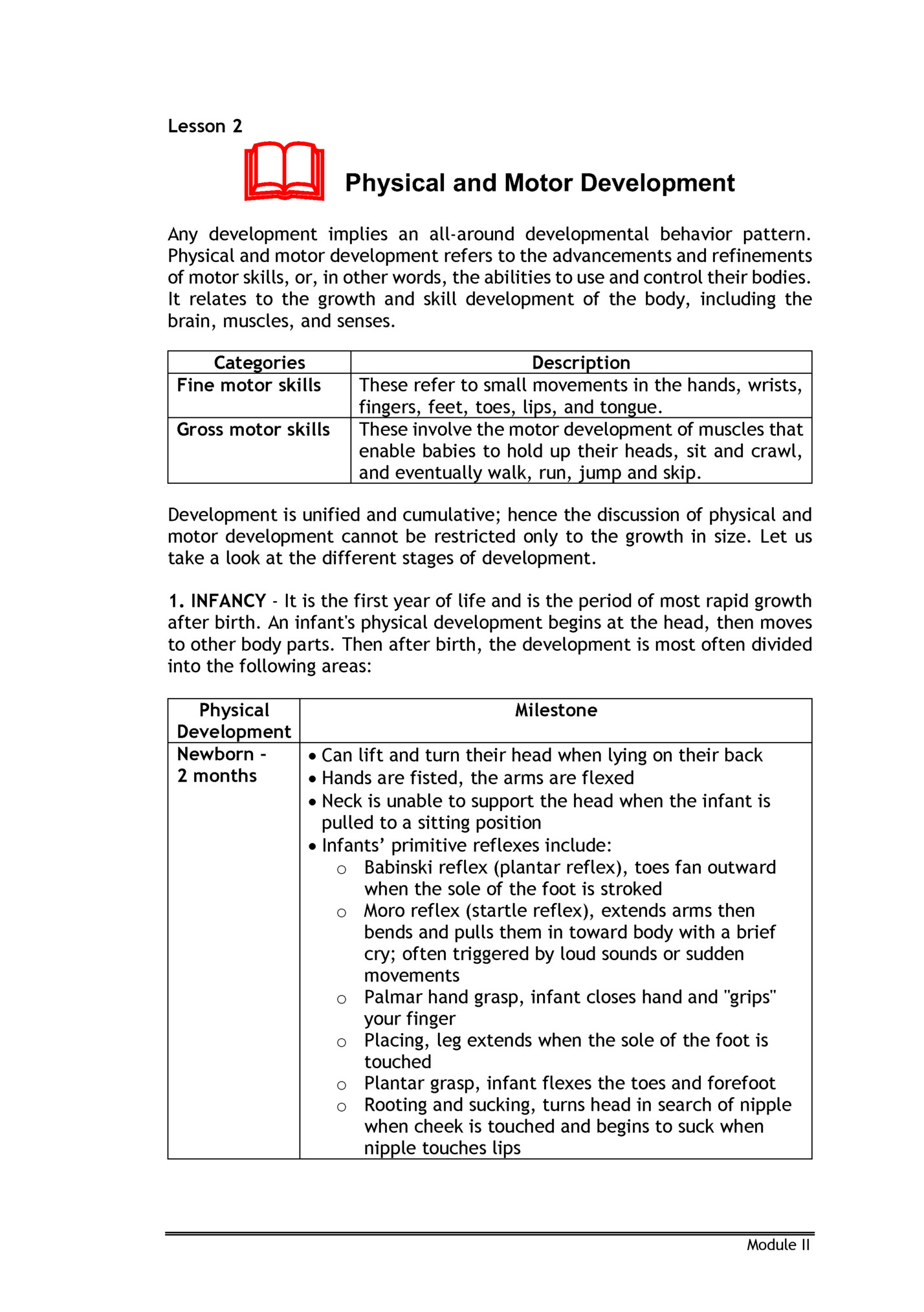
5-6 months 6-9 months 9-12 months o Stepping and walking, take brisk steps when both feet are placed on a surface, with the body supported o Tonic neck response, left arm extends when infant gazes to the left, while right arm and leg flex inward, and vice versa • Better eye-muscle control allows the infant to track objects. • Begins to control hand and feet actions, but these movements are not fine-tuned. The infant may begin to use both hands, working together, to accomplish tasks. The infant is still unable to coordinate the grasp but swipes at objects to bring them closer. • Increased vision allows the infant to tell objects apart from backgrounds with very little contrast (such as a button on a blouse of the same color). • Infant raises up (upper torso, shoulders, and head) with arms when lying face down (on tummy). • Neck muscles are developed enough to allow the infant to sit with support, and keep its head up. • Primitive reflexes have either already disappeared, or are starting to disappear. • Able to sit alone, without support, for only moments at first, and then for up to 30 seconds or more. • Infant begins to grasp blocks or cubes using the ulnarpalmar grasp technique (pressing the block into the palm of the hand while flexing or bending wrist in) but does not yet use thumb. • Infant rolls from back to stomach. When on the tummy, the infant can push up with arms to raise the shoulders and head and look around or reach for objects. • Crawling may begin • Infant can walk while holding an adult's hand • Infant is able to sit steadily, without support, for long periods of time • Infant learns to sit down from a standing position • Infant may pull into and keep a standing position while holding onto furniture • Infant begins to balance while standing alone • Infant takes steps holding a hand; may take few steps alone Sensory Milestone Development Vision • The newborn infant can see within a close range of 8 to 12 inches (20 to 30 centimeters). Color vision develops between 4 to 6 months. By 2 months, can track moving objects up to 180 degrees and prefers faces. Module II

Fleepit Digital © 2021